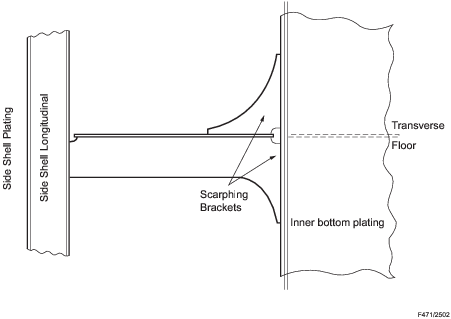7.2.1 Hopper
side structure is typically arranged in self-unloading bulk carriers.
7.2.2 The sloped
hopper structure, clear of the hopper side tank structure, on self-unloading
bulk carriers, is not normally included in the longitudinal strength
calculations. Where it is included in the longitudinal or transverse
strength calculations, the structure is to be specially considered.
7.2.3 Where the
structure is longitudinally framed, transverses are to be arranged
in the hopper side structure in alignment with the double bottom floors
to ensure continuity of transverse strength.
7.2.4 The scantlings
of hopper structures are to be determined to satisfy the following:
-
Deep tank requirements
if applicable.
-
Cargo loading requirements.
The deep tank requirements are given in Rules for Ships, Table 1.9.1 Watertight and deep tank bulkhead
scantlings. The cargo loading
requirements are to be specially considered.
7.2.5 The scantlings
of the sloped hopper bulkhead transverses are to comply with the requirements
of Table 7.9.1 Hopper tank primary
structure of
the Rules for Ships, with a maximum stowage rate of 1,00 m3/tonne.
Alternative scantlings may be considered based on direct calculations.
7.2.6 Where the
breadth of the double bottom structure exceeds the breadth of the
hopper tank structure over the breadth of the ship, suitable scarphing
of the inner bottom plating is to be arranged into the wing bottom
structure by horizontal scarphing brackets, fitted in line with the
inner bottom plating at each transverse. These brackets are to be
arranged on each side of the transverse, see
Figure 4.7.1 Scarphing of inner bottom plating into the wing/hopper side structure.
7.2.7 Where the
bottom and side shell structure and the sloped longitudinal bulkhead
are transversely framed, the transverse web frames are to be in line
with the double bottom floors and the single bottom floors integrated
into the double bottom structure, see
Figure 4.8.1 Floor.

Figure 4.7.1 Scarphing of inner bottom plating into the wing/hopper side structure